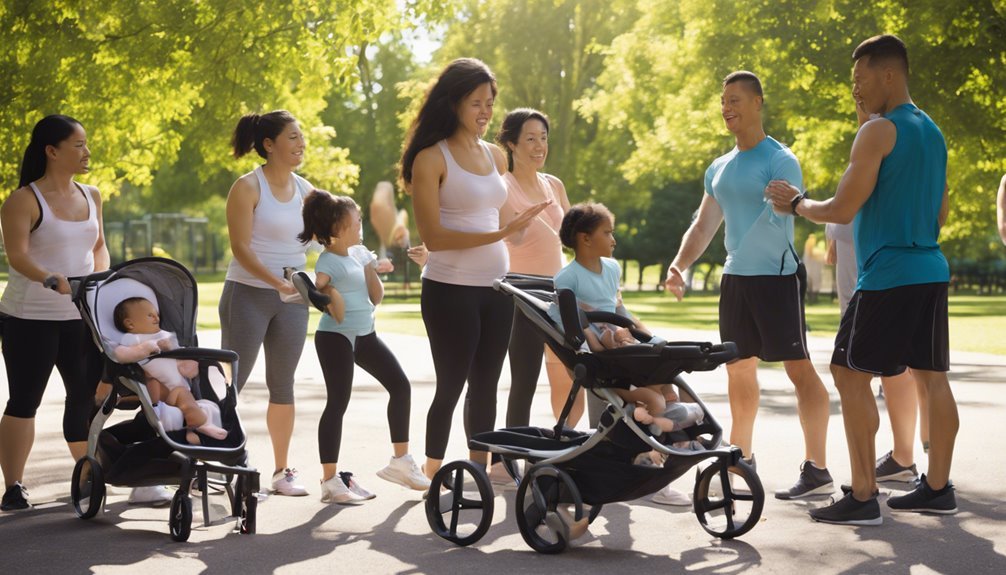Did you know that nearly 80% of new parents find it challenging to maintain physical fitness after the birth of a child? Balancing your well-being with the demands of a newborn isn't just possible; it's essential for both your health and your ability to care for your baby. You'll discover that integrating short, effective workouts during baby's naptime or engaging in baby-inclusive exercises can not only help regain your pre-baby fitness level but also strengthen the bond with your little one. Curious about how you can incorporate these practices into your daily routine and what specific exercises are best suited for this unique period in your life? Let's explore some practical strategies that cater to your new lifestyle.
Key Takeaways
- Integrate baby-inclusive workouts like squats and lunges to bond while enhancing physical fitness.
- Utilize baby's nap times for focused exercises like yoga or bodyweight routines.
- Set realistic fitness goals, such as a daily 10-minute workout, and track your progress.
- Prepare meals in advance during nap times to maintain a healthy diet without stress.
- Join parent fitness groups for community support and motivation.
Prioritizing Self-Care
Amid the joy and chaos of life with a newborn, it's easy to put your own needs last, but prioritizing self-care isn't just good for you—it's essential.
When you're dedicated to serving not just your baby, but also your family and community, taking time for your own well-being allows you to serve them better.
Start by integrating mindful moments into your daily routine. You don't need hours; just a few minutes can make a significant difference.
While your baby naps, instead of rushing to complete chores, spend a few moments in self-reflection. Ask yourself how you're feeling, what you need, and acknowledge your thoughts without judgment.
Engage in self-reflection practices that resonate with you. It could be journaling your thoughts, meditating for five minutes, or simply sitting quietly with a cup of tea.
These practices help you maintain a sense of self amidst the demands of parenthood.
Setting Realistic Goals
When setting goals as a new parent, it's crucial to keep them achievable and tailored to your current lifestyle. Balancing baby care with personal health requires setting realistic expectations. Start by defining what fitness means for you now, which might look different than it did before. Remember, it's about progress, not perfection.
Establishing achievable milestones is key. Perhaps you aim for a daily 10-minute workout instead of an hour at the gym. Celebrate these small victories; they add up and contribute to your overall well-being.
Additionally, listen to your body and recognize that some days will be better than others. Flexibility is your ally.
It's also helpful to jot down your goals. Writing them makes them more concrete, and checking off completed tasks can provide a sense of accomplishment and a visual reminder of your commitment to your health. This practice not only keeps you on track but also gently guides you back if you stray.
Above all, be kind to yourself. You're doing incredible work raising a child and focusing on your fitness is a testament to your strength.
Baby-Inclusive Workouts
Integrating your baby into your workout routine can be a wonderful way to stay fit while bonding with your little one. It's about making fitness fun and engaging for both of you.
Start with simple exercises like baby squats. Hold your baby close and squat; it's an effective way to strengthen your legs and back while giving your baby a giggle. Lunges are another great option. Step forward with one leg, lowering your hips until both knees are bent at about a 90-degree angle. This movement not only helps tone your legs but also keeps your baby entertained with the gentle rocking motion.
You can also try 'baby bench presses' by lying on your back and safely lifting your baby up and down. This not only works your arms but also encourages eye contact and smiles, enhancing baby bonding.
Always ensure your baby's safety during these activities, using secure holds and paying attention to their reactions and comfort.
Incorporating your baby into your workout routine isn't just about getting back in shape; it's a precious opportunity to strengthen the emotional bond between you and your child.
Utilizing Nap Times
While including your baby in workout routines is a wonderful way to bond, the times when your little one is napping offer a golden opportunity to focus on your personal fitness goals.
Understanding effective napping strategies can significantly enhance these precious moments. Establishing a consistent nap schedule ensures you know exactly when you'll have time for yourself. This predictability allows you to plan and execute your fitness activities more efficiently.
During these quiet times, consider engaging in activities that won't wake your baby. Opt for exercises that are relatively silent yet effective, such as yoga, pilates, or a series of controlled bodyweight exercises.
These quiet activities not only keep the noise down but also help you stay flexible and strong.
Quick Home Exercise Routines

Many new parents find it challenging to fit extensive workouts into their bustling daily routines. However, you can still maintain your fitness with quick home exercise routines that maximize your time and energy.
These routines can be squeezed into your day without needing extra equipment or long periods, making them perfect for your new lifestyle.
Here's a practical approach to staying active:
- Bodyweight Exercises: Utilize simple moves like push-ups, squats, and lunges. These exercises use your own body's weight to build muscle and increase heart rate, offering a comprehensive workout in just a few minutes.
- Interval Training: Incorporate short bursts of intense activity followed by brief rest periods. This method boosts your metabolism and can be more effective than steady-state cardio, especially when time is limited.
- Core Strengthening: Focus on planks and abdominal crunches to strengthen your midsection. A strong core is essential for good posture and reducing back pain, which is crucial as you handle your newborn.
- Stretching: End your routine with a few minutes of stretching to improve flexibility and decrease muscle tension. This helps in recovery and ensures you're ready to tackle your parental duties without discomfort.
Walking With the Stroller
Stroller walks offer a fantastic way to combine fresh air and physical activity while bonding with your baby. You're not just pushing a stroller; you're steering a little adventure that benefits both of you.
The rhythmic motion can soothe your newborn, giving them comfort and warmth from your proximity, while you gain the much-needed exercise and mental refreshment from being outdoors.
Prioritize stroller safety by ensuring your stroller is sturdy, the brakes work well, and the harness is secure. Check the weather to dress your baby appropriately, and don't forget sunscreen for both of you on sunny days.
Start with short walks around your neighborhood. As you both adapt, you can gradually increase the distance and explore new terrains.
Parks and pedestrian paths are great for these outdoor adventures, offering both smooth surfaces for ease of strolling and stimulating environments that keep your walks interesting.
Joining Parent Fitness Groups

Joining a parent fitness group can offer you not only a chance to stay fit but also to connect with others who are navigating the journey of new parenthood.
It's a fantastic way to meet new friends who understand exactly what you're going through and can share tips and tricks to make your days (and workouts) a bit easier.
These groups provide a unique blend of community support and fitness opportunities that cater specifically to parents.
You'll find that the encouragement from your group helps keep you motivated, even on those tougher days.
Here are a few benefits you can expect:
- Group Accountability: Knowing others are counting on you can boost your commitment to staying active.
- Emotional Support: Share your experiences and challenges in a supportive environment.
- Flexible Scheduling: Many groups offer virtual workout sessions, making it easier to fit exercise into your busy life.
- Diverse Activities: From yoga to strength training, there's likely something for everyone.
Healthy Meal Planning
While staying active is important, equally vital is what you put on your plate. With a newborn at home, planning your meals can seem like a daunting task, but it's essential for both your health and your ability to care for your little one.
Let's dive into how you can manage this effectively.
Start with meal prep—it's a lifesaver. Dedicate a couple of hours each week to prepare bulk meals that are healthy and easy to reheat. Think whole grains, lean proteins, and plenty of vegetables. This way, you're not tempted to reach for less healthy options when you're tired or pressed for time.
Don't forget about nutritious snacks. Keeping fruits, nuts, and yogurt on hand can stave off hunger and provide you with a much-needed energy boost.
These small bites can be lifesavers when you're on a non-stop schedule with a newborn.
Stretching for Relaxation

After tackling meal prep, consider the calming benefits of stretching. When you've got a newborn at home, finding moments for yourself can seem nearly impossible.
Yet, dedicating even a few minutes to gentle stretches can significantly enhance your well-being. It's not just about physical health; it's about carving out a quiet space in your day to reconnect with yourself through mindful breathing and movement.
Here are a few ways to integrate stretching into your daily routine:
- Morning Wake-Up: Before the baby wakes up, spend five minutes doing light stretches to awaken your body and mind.
- Naptime Calm: Use your baby's naptime to engage in a short stretching session. This can help release any tension built up from childcare duties.
- Evening Wind-Down: After your baby is asleep, allow yourself 10 minutes of stretching combined with deep, mindful breathing to help you relax before bed.
- Baby's Playtime: While your baby is on their playmat, join them on the floor for some gentle stretches. It's a great way to stay close and engage with your baby.
Strength Training Basics
Building strength is essential, not just for your overall health but also for keeping up with the demands of a new baby. You can start with simple bodyweight exercises, which don't require any equipment and can be done right at home.
Think about incorporating squats, lunges, and push-ups into your daily routine. These exercises aren't only effective but also save time, which is precious when you're caring for a newborn.
Additionally, using resistance bands can enhance your workout without needing heavy weights. These bands are fantastic because they're light, portable, and can be adjusted to increase or decrease resistance as needed.
You can loop a band around your legs during squats or use it for arm curls. This flexibility allows you to build strength in a way that suits your current fitness level and postpartum recovery.
Yoga for Parents and Babies

Shifting your focus to a gentler form of physical activity, consider exploring yoga with your baby. Baby yoga isn't just about achieving a great stretch; it's a fantastic way to deepen your bond while supporting your own postpartum recovery.
Through mindful breathing and gentle movements, you'll find both relaxation and rejuvenation, crucial for your new role as a parent.
Here are some practical tips to get started:
- Start Simple: Choose basic poses that accommodate baby's presence, like "cat-cow" or "butterfly". Ease into each pose without rushing.
- Engage Your Baby: Incorporate your baby into poses either by holding them or laying them on your yoga mat. Make eye contact and talk to them, turning this into a playful interaction.
- Focus on Breath: Emphasize mindful breathing to help center your thoughts and soothe both you and your baby.
- Regular Routine: Try to establish a routine that fits your new lifestyle. Even a few minutes can make a significant difference in your day.
Tracking Progress and Adjustments
As you integrate yoga into your daily routine, it's important to track your progress and make necessary adjustments. Keeping a log of your yoga sessions not only helps you see how far you've come, but it also allows you to tweak your routine to better serve your body's needs and those of your newborn. It's about finding what works best for both of you.
Start by noting down the duration and type of yoga poses you do each day. How do you feel afterwards? Energized? Relaxed? Over time, you'll begin to notice patterns. Maybe you're more consistent in the morning, or perhaps certain poses seem easier or more challenging on different days. This progress tracking is crucial for understanding how yoga fits into your life as a new parent.
Don't hesitate to adjust your goals as you go. Maybe initially, you aimed to practice yoga for 30 minutes daily, but with a newborn, finding that block of time is tough. It's okay to break it down into shorter, more manageable sessions.
Flexibility is key. These adjustment strategies aren't just about modifying your expectations; they're about optimizing your well-being and that of your family. Keep adapting, and you'll find your balance.
Frequently Asked Questions
How Can Partners Support Each Other's Fitness Goals Post-Baby?
To support each other's fitness goals, it's crucial to share responsibilities around the house.
You'll free up time for workouts by taking turns caring for your baby. Motivate each other by setting common goals and celebrating achievements, no matter how small.
Remember, you're both adjusting to new roles, so be patient and encouraging.
Your joint efforts not only boost your health but also strengthen your bond as partners and co-parents.
What Are Safe Postpartum Exercises for Cesarean Recovery?
Starting your recovery after a cesarean, you'll want to focus on gentle stretching and strengthening your pelvic floor.
These exercises aren't only safe but also crucial for your healing. Begin with light walking and gradually include pelvic tilts and kegel exercises.
It's essential to listen to your body and avoid overexertion. You're doing an incredible job, and taking this step to care for your body is both brave and beneficial.
How Does Breastfeeding Impact a Mother's Fitness Routine?
Breastfeeding impacts your fitness routine by increasing calorie consumption, but it also offers benefits like weight loss postpartum.
You'll need to adjust your exercise schedule around nursing times, ensuring you're fueled and hydrated.
Remember, it's okay to start slow and gradually increase intensity.
Keep listening to your body and be patient with your progress.
This not only helps you regain strength but also supports your baby's health and development.
Are There Specific Exercises to Avoid While Healing From Childbirth?
You should avoid high-impact exercises and intense core strengthening while healing from childbirth.
These activities can strain your body too soon, potentially hindering your recovery.
Focus instead on gentle, low-impact movements that nurture your body.
As you regain strength, gradually reintroduce more challenging exercises.
Can Babywearing Substitute for a Structured Workout?
Babywearing can't entirely replace a structured workout, but it does offer great benefits.
You'll burn extra calories and strengthen your muscles simply by carrying your baby's weight. It's a practical way to boost your fitness routine while bonding with your little one.
Try to incorporate additional activities like walking or gentle stretching to fully address your fitness needs.
You're doing wonderfully by fitting in physical activity wherever you can!
Conclusion
You've got this! Prioritize self-care, set realistic goals, and blend baby-inclusive workouts into your day. Utilize nap times for some quiet yoga or a bodyweight routine. Whether it's stretching for relaxation, dabbling in strength training, or trying yoga with your baby, each step is a leap towards your wellness. Keep tracking your progress and make adjustments as needed. Remember, staying fit isn't just for you; it's for your baby too. Together, you'll thrive.




